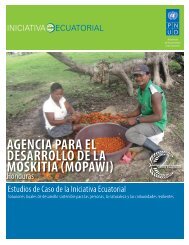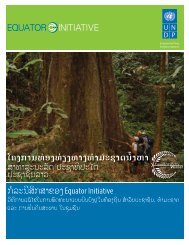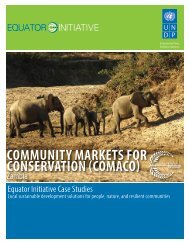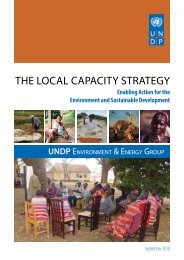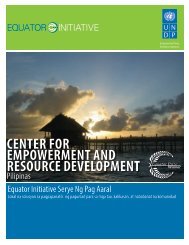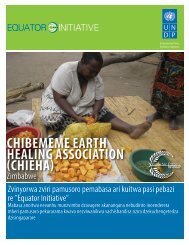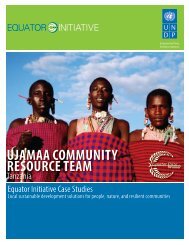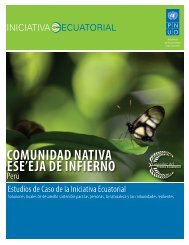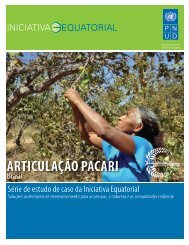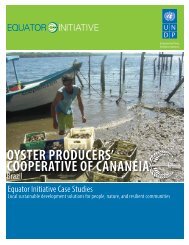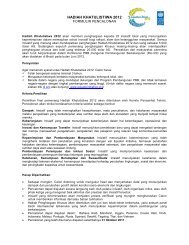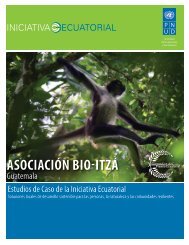AMAL-CRAB BAY Community Resource Management Initiative
AMAL-CRAB BAY Community Resource Management Initiative
AMAL-CRAB BAY Community Resource Management Initiative
Create successful ePaper yourself
Turn your PDF publications into a flip-book with our unique Google optimized e-Paper software.
Background and Context<br />
Crab Bay is a critically important area for biodiversity in the Pacific<br />
archipelago of Vanuatu, situated in Malampa Province, on the central<br />
eastern coastline of the island of Malekula. The bay forms part of the<br />
Port Stanley mangrove area, and is composed of extensive fringing<br />
reefs with sea grass beds. The area is particularly well-known for its<br />
high abundance of crabs, hence its name; the bay is also home to<br />
a high diversity of invertebrate species and fin fishes, and provides<br />
roosting and feeding grounds for a variety of internationally<br />
endangered species such as turtles, dugongs, and some terrestrial<br />
mammals.<br />
The local populations of Crab Bay and the neighbouring area of<br />
Amal totaled around 1,500 in 2005, living in sixteen communities<br />
dispersed along the eastern coastline. These indigenous Melanesian<br />
communities speak the uripiv dialect and share traditional<br />
customary beliefs typical of the “small Nambas” people of central<br />
Malekula. Approximately eighty percent of the population is<br />
engaged in fishing and farming to feed their families and earn cash<br />
income; the remaining twenty percent are paid workers at the area’s<br />
two large employers: a cattle ranch and a coconut plantation. A<br />
high percentage of local people use the bay’s marine resources to<br />
supplement their income and meet food security needs; the table<br />
below demonstrates the extent to which coastal communities are<br />
reliant on the area’s natural resources for their subsistence and<br />
livelihoods.<br />
Cardisoma carnifex: a critical local resource<br />
One important source of protein is the land crab Cardisoma carnifex<br />
– these are harvested daily by women who trade surplus catches for<br />
cash at the local markets. Harvesting of land crabs for subsistence<br />
dates to the 1980s; prior to this, French plantation owners had<br />
restricted local access to the Crab Bay and Amal areas, allowing the<br />
species to flourish.<br />
With an increasing population and the advent of a cash economy<br />
leading to an increased demand for cash income, the supply of<br />
land crabs in the bay began to decline in the late 1990s. Within a<br />
few years, crab collectors reported finding it increasingly difficult to<br />
harvest a sufficient number of crabs; their collecting methods were,<br />
conversely, seen as the cause of this decline. Collectors were using<br />
baits and nets to trap crabs, as well as digging out individuals from<br />
holes and using lights in night fishing to bundle enough crabs for<br />
sale in nearby markets. In September 2002, in response to the trend<br />
of declining land crab numbers, community chiefs instituted a tabu<br />
on the mangrove forests and reefs within the bay to prohibit crab<br />
collection, supported by the Malampa Provincial Authority. This<br />
use of a customary resource prohibition effectively established a<br />
temporary no-take zone, aimed at allowing the replenishment of<br />
crab resources. This created the Amal-Krabbei Tabu Eria (AKTE); a<br />
management committee was subsequently established to oversee<br />
its implementation, marking the beginning of the Amal-Crab Bay<br />
<strong>Community</strong> <strong>Resource</strong> <strong>Management</strong> <strong>Initiative</strong>.<br />
The initial process of instituting the tabu was undertaken without<br />
providing clear information to the rest of the community about<br />
either its purpose or the rules they were supposed to observe,<br />
however. Consequently, poaching activities persisted in the tabu<br />
area. Weak management of the marine area was compounded by<br />
a lack of ecological information on land crabs, meaning that the<br />
evidence base for prohibiting their harvesting was lacking. Finally,<br />
existing national policies and legislation that could have supported<br />
local action were instead focused on high-value commercial species,<br />
and gave less consideration to resources such as the land crab that<br />
are used primarily for subsistence needs.<br />
International support catalyzing improved management<br />
In November 2003, the International Waters Project (IWP) chose<br />
AKTE as the site for its pilot programme on community resource<br />
management in Vanuatu. The IWP ran from 2000 to 2006, working<br />
with pilot communities in fourteen Pacific Island countries to<br />
find practical ways to strengthen environmental management in<br />
three key areas: coastal fisheries, waste reduction, and freshwater<br />
4



